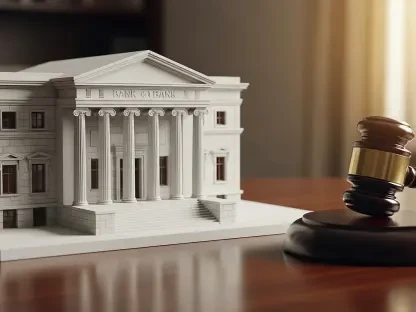The landscape of artificial intelligence (AI) regulation in the United States stands at a critical juncture, with tensions boiling over between federal and state authorities, as a staggering 70% of tech industry leaders, according to recent surveys, believe that fragmented state-level AI policies could cripple innovation if left unchecked. This concern has come to a head with a draft executive order from the White House under President Trump, aimed at curbing state AI laws in favor of centralized federal oversight. This roundup dives into the diverse opinions, insights, and debates surrounding this bold move, gathering perspectives from policymakers, legal scholars, industry stakeholders, and state officials to unpack the implications of this federal power play.
Federal vs. State Authority: The Core of the AI Regulatory Debate
Tensions Over Federal Preemption
The proposed executive order seeks to empower federal agencies like the Department of Commerce and the Federal Trade Commission to challenge state AI regulations on grounds such as interference with interstate commerce. Industry advocates argue that a unified national framework could ease compliance burdens for AI developers, who often struggle with navigating a patchwork of state rules. Many in the tech sector view this as a necessary step to maintain economic competitiveness on a global scale.
On the flip side, state officials express alarm over what they see as an overreach of federal authority. They contend that states have historically been laboratories for innovation, crafting policies tailored to local needs and values. The idea of federal agencies potentially withholding broadband funds to pressure compliance has sparked accusations of coercion rather than collaboration.
A third perspective comes from policy analysts who highlight the practical challenges of implementation. Even if the order is enacted, aligning federal and state priorities in a field as dynamic as AI poses logistical hurdles. Questions remain about how federal agencies will define which state laws are “onerous” and whether such determinations will hold up under scrutiny.
Political Motivations Behind Centralization
Republican leaders frame the push for centralized AI oversight as a defense against ideologically driven state policies that could stifle technological progress. They argue that without a singular federal standard, companies face the risk of conflicting mandates that could derail investment and growth. This viewpoint resonates with many business leaders who prioritize operational clarity over regional diversity in regulation.
However, critics from progressive-leaning states see this as a political maneuver to suppress dissenting approaches to AI governance. They suggest that federal control might prioritize corporate interests over public safety or ethical considerations, which states often emphasize in their laws. This divide reflects broader ideological battles playing out in the tech policy arena.
Some neutral observers note that the political rhetoric on both sides may oversimplify the issue. While federal uniformity could streamline certain processes, it risks sidelining innovative state-level experiments that have historically driven tech policy forward. The balance between these competing priorities remains a point of heated discussion among stakeholders.
Voices of Opposition and Support
State Resistance to Federal Overreach
State legislators, particularly from tech-heavy regions like California, vehemently oppose the draft order, arguing that it undermines their authority to regulate emerging technologies within their borders. They emphasize that state laws often address specific community concerns, such as data privacy or algorithmic bias, which might be overlooked in a broad federal framework. This perspective underscores a deep commitment to maintaining local control over AI’s societal impact.
Legal scholars add another layer of critique, questioning the constitutional basis for such sweeping federal preemption. Many argue that the Commerce Clause, often cited as justification for federal intervention, does not grant unlimited power to override state laws, especially in areas traditionally under state purview. This legal uncertainty could pave the way for courtroom battles if the order moves forward.
A less vocal but significant concern comes from smaller states, which worry that federal dominance might drown out their unique needs. Unlike larger states with robust tech industries, these regions fear that a one-size-fits-all policy could leave them at a disadvantage, unable to tailor regulations to their economic realities. This diversity of state-level pushback illustrates the complexity of achieving consensus.
Industry and Federal Support for Uniformity
In contrast, many tech industry leaders applaud the White House’s initiative, citing the chaos of complying with varied state regulations as a major barrier to innovation. They argue that a cohesive national standard would provide predictability, enabling companies to allocate resources more efficiently rather than grappling with a maze of conflicting rules. This sentiment is particularly strong among AI startups seeking to scale across state lines.
Federal proponents echo this stance, stressing that fragmented policies could weaken the United States’ position in the global AI race. They point to the need for a unified front to counter international competitors who operate under more streamlined regulatory systems. For these advocates, the executive order represents a pragmatic solution to a pressing economic challenge.
Yet, even within this camp, some caution against overly rigid federal rules. A subset of industry voices suggests that while uniformity is desirable, it must be balanced with flexibility to adapt to AI’s rapid evolution. This nuanced support highlights that even proponents of centralization recognize potential pitfalls in the approach.
Broader Implications for AI Policy
Legal and Constitutional Questions
The draft order has ignited a firestorm of debate over its legal grounding, with many experts warning that broad federal preemption could face significant challenges in court. They note that past attempts to override state authority in other sectors have met mixed success, often hinging on narrow interpretations of federal power. This uncertainty casts a shadow over the order’s long-term viability.
Beyond the courtroom, the debate touches on fundamental questions of federalism in a digital age. Some policy thinkers argue that AI, as a borderless technology, inherently demands federal oversight, while others counter that states are better positioned to respond to its localized impacts. This philosophical split underscores the difficulty of crafting a governance model for such a transformative field.
A practical concern raised by legal analysts centers on enforcement mechanisms. Even if the order withstands legal scrutiny, the process of reviewing and challenging state laws within tight timelines could strain federal resources. This logistical angle adds another dimension to the already contentious discussion around implementation.
Innovation vs. Regulation Balance
One recurring theme in the roundup is the tension between fostering AI innovation and ensuring adequate regulation. Industry stakeholders often emphasize that overregulation at any level—state or federal—could dampen creativity and slow technological advancement. They advocate for light-touch policies that prioritize growth over restriction.
Conversely, state-level voices argue that unchecked innovation can lead to societal harms, such as biased algorithms or privacy violations, which require proactive oversight. They view state regulations as critical safeguards that fill gaps left by federal inaction. This perspective prioritizes public interest over unbridled development.
A middle-ground opinion suggests that the debate need not be zero-sum. Some policy experts propose hybrid models where federal guidelines set baseline standards, while states retain leeway to experiment with stricter or more tailored rules. This compromise, though appealing in theory, faces significant hurdles in practice given the current political climate.
Reflecting on the AI Regulatory Clash
Looking back, the discourse surrounding the White House’s draft executive order revealed a deeply divided landscape, with federal proponents, state defenders, industry players, and legal minds each staking out distinct positions. The clash illuminated not just the specifics of AI policy, but also broader questions about power distribution in a tech-driven era. Moving forward, stakeholders can take actionable steps by closely tracking federal announcements and engaging with state-level advocacy groups to influence outcomes. Additionally, AI developers might consider forming coalitions to propose balanced regulatory frameworks, while policymakers could explore pilot programs to test hybrid governance models. These efforts, though incremental, could pave the way toward resolving the tension and shaping a future where innovation and oversight coexist more harmoniously.









